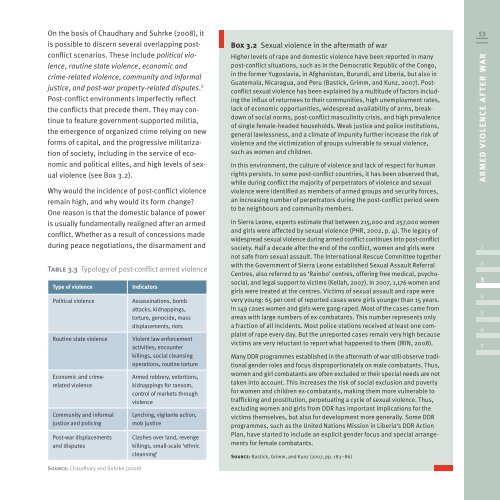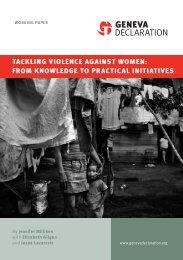Global Burden of Armed Violence - The Geneva Declaration on ...
Global Burden of Armed Violence - The Geneva Declaration on ...
Global Burden of Armed Violence - The Geneva Declaration on ...
You also want an ePaper? Increase the reach of your titles
YUMPU automatically turns print PDFs into web optimized ePapers that Google loves.
On the basis <str<strong>on</strong>g>of</str<strong>on</strong>g> Chaudhary and Suhrke (2008), it<br />
is possible to discern several overlapping postc<strong>on</strong>flict<br />
scenarios. <str<strong>on</strong>g>The</str<strong>on</strong>g>se include political violence,<br />
routine state violence, ec<strong>on</strong>omic and<br />
crime-related violence, community and informal<br />
justice, and post-war property-related disputes. 5<br />
Post-c<strong>on</strong>flict envir<strong>on</strong>ments imperfectly reflect<br />
the c<strong>on</strong>flicts that precede them. <str<strong>on</strong>g>The</str<strong>on</strong>g>y may c<strong>on</strong>tinue<br />
to feature government-supported militia,<br />
the emergence <str<strong>on</strong>g>of</str<strong>on</strong>g> organized crime relying <strong>on</strong> new<br />
forms <str<strong>on</strong>g>of</str<strong>on</strong>g> capital, and the progressive militarizati<strong>on</strong><br />
<str<strong>on</strong>g>of</str<strong>on</strong>g> society, including in the service <str<strong>on</strong>g>of</str<strong>on</strong>g> ec<strong>on</strong>omic<br />
and political elites, and high levels <str<strong>on</strong>g>of</str<strong>on</strong>g> sexual<br />
violence (see Box 3.2).<br />
Why would the incidence <str<strong>on</strong>g>of</str<strong>on</strong>g> post-c<strong>on</strong>flict violence<br />
remain high, and why would its form change?<br />
One reas<strong>on</strong> is that the domestic balance <str<strong>on</strong>g>of</str<strong>on</strong>g> power<br />
is usually fundamentally realigned after an armed<br />
c<strong>on</strong>flict. Whether as a result <str<strong>on</strong>g>of</str<strong>on</strong>g> c<strong>on</strong>cessi<strong>on</strong>s made<br />
during peace negotiati<strong>on</strong>s, the disarmament and<br />
Table 3.3 Typology <str<strong>on</strong>g>of</str<strong>on</strong>g> post-c<strong>on</strong>flict armed violence<br />
Type <str<strong>on</strong>g>of</str<strong>on</strong>g> violence Indicators<br />
Political violence Assassinati<strong>on</strong>s, bomb<br />
attacks, kidnappings,<br />
torture, genocide, mass<br />
displacements, riots<br />
Routine state violence Violent law enforcement<br />
activities, encounter<br />
killings, social cleansing<br />
operati<strong>on</strong>s, routine torture<br />
Ec<strong>on</strong>omic and crime-<br />
related violence<br />
Community and informal<br />
justice and policing<br />
Post-war displacements<br />
and disputes<br />
Source: Chaudhary and Suhrke (2008)<br />
<str<strong>on</strong>g>Armed</str<strong>on</strong>g> robbery, extorti<strong>on</strong>s,<br />
kidnappings for ransom,<br />
c<strong>on</strong>trol <str<strong>on</strong>g>of</str<strong>on</strong>g> markets through<br />
violence<br />
Lynching, vigilante acti<strong>on</strong>,<br />
mob justice<br />
Clashes over land, revenge<br />
killings, small-scale ‘ethnic<br />
cleansing’<br />
Box 3.2 Sexual violence in the aftermath <str<strong>on</strong>g>of</str<strong>on</strong>g> war<br />
Higher levels <str<strong>on</strong>g>of</str<strong>on</strong>g> rape and domestic violence have been reported in many<br />
post-c<strong>on</strong>flict situati<strong>on</strong>s, such as in the Democratic Republic <str<strong>on</strong>g>of</str<strong>on</strong>g> the C<strong>on</strong>go,<br />
in the former Yugoslavia, in Afghanistan, Burundi, and Liberia, but also in<br />
Guatemala, Nicaragua, and Peru (Bastick, Grimm, and Kunz, 2007). Postc<strong>on</strong>flict<br />
sexual violence has been explained by a multitude <str<strong>on</strong>g>of</str<strong>on</strong>g> factors including<br />
the influx <str<strong>on</strong>g>of</str<strong>on</strong>g> returnees to their communities, high unemployment rates,<br />
lack <str<strong>on</strong>g>of</str<strong>on</strong>g> ec<strong>on</strong>omic opportunities, widespread availability <str<strong>on</strong>g>of</str<strong>on</strong>g> arms, breakdown<br />
<str<strong>on</strong>g>of</str<strong>on</strong>g> social norms, post-c<strong>on</strong>flict masculinity crisis, and high prevalence<br />
<str<strong>on</strong>g>of</str<strong>on</strong>g> single female-headed households. Weak justice and police instituti<strong>on</strong>s,<br />
general lawlessness, and a climate <str<strong>on</strong>g>of</str<strong>on</strong>g> impunity further increase the risk <str<strong>on</strong>g>of</str<strong>on</strong>g><br />
violence and the victimizati<strong>on</strong> <str<strong>on</strong>g>of</str<strong>on</strong>g> groups vulnerable to sexual violence,<br />
such as women and children.<br />
In this envir<strong>on</strong>ment, the culture <str<strong>on</strong>g>of</str<strong>on</strong>g> violence and lack <str<strong>on</strong>g>of</str<strong>on</strong>g> respect for human<br />
rights persists. In some post-c<strong>on</strong>flict countries, it has been observed that,<br />
while during c<strong>on</strong>flict the majority <str<strong>on</strong>g>of</str<strong>on</strong>g> perpetrators <str<strong>on</strong>g>of</str<strong>on</strong>g> violence and sexual<br />
violence were identified as members <str<strong>on</strong>g>of</str<strong>on</strong>g> armed groups and security forces,<br />
an increasing number <str<strong>on</strong>g>of</str<strong>on</strong>g> perpetrators during the post-c<strong>on</strong>flict period seem<br />
to be neighbours and community members.<br />
In Sierra Le<strong>on</strong>e, experts estimate that between 215,000 and 257,000 women<br />
and girls were affected by sexual violence (PHR, 2002, p. 4). <str<strong>on</strong>g>The</str<strong>on</strong>g> legacy <str<strong>on</strong>g>of</str<strong>on</strong>g><br />
widespread sexual violence during armed c<strong>on</strong>flict c<strong>on</strong>tinues into post-c<strong>on</strong>flict<br />
society. Half a decade after the end <str<strong>on</strong>g>of</str<strong>on</strong>g> the c<strong>on</strong>flict, women and girls were<br />
not safe from sexual assault. <str<strong>on</strong>g>The</str<strong>on</strong>g> Internati<strong>on</strong>al Rescue Committee together<br />
with the Government <str<strong>on</strong>g>of</str<strong>on</strong>g> Sierra Le<strong>on</strong>e established Sexual Assault Referral<br />
Centres, also referred to as ‘Rainbo’ centres, <str<strong>on</strong>g>of</str<strong>on</strong>g>fering free medical, psychosocial,<br />
and legal support to victims (Kellah, 2007). In 2007, 1,176 women and<br />
girls were treated at the centres. Victims <str<strong>on</strong>g>of</str<strong>on</strong>g> sexual assault and rape were<br />
very young: 65 per cent <str<strong>on</strong>g>of</str<strong>on</strong>g> reported cases were girls younger than 15 years.<br />
In 149 cases women and girls were gang-raped. Most <str<strong>on</strong>g>of</str<strong>on</strong>g> the cases came from<br />
areas with large numbers <str<strong>on</strong>g>of</str<strong>on</strong>g> ex-combatants. This number represents <strong>on</strong>ly<br />
a fracti<strong>on</strong> <str<strong>on</strong>g>of</str<strong>on</strong>g> all incidents. Most police stati<strong>on</strong>s received at least <strong>on</strong>e complaint<br />
<str<strong>on</strong>g>of</str<strong>on</strong>g> rape every day. But the unreported cases remain very high because<br />
victims are very reluctant to report what happened to them (IRIN, 2008).<br />
Many DDR programmes established in the aftermath <str<strong>on</strong>g>of</str<strong>on</strong>g> war still observe traditi<strong>on</strong>al<br />
gender roles and focus disproporti<strong>on</strong>ately <strong>on</strong> male combatants. Thus,<br />
women and girl combatants are <str<strong>on</strong>g>of</str<strong>on</strong>g>ten excluded or their special needs are not<br />
taken into account. This increases the risk <str<strong>on</strong>g>of</str<strong>on</strong>g> social exclusi<strong>on</strong> and poverty<br />
for women and children ex-combatants, making them more vulnerable to<br />
trafficking and prostituti<strong>on</strong>, perpetuating a cycle <str<strong>on</strong>g>of</str<strong>on</strong>g> sexual violence. Thus,<br />
excluding women and girls from DDR has important implicati<strong>on</strong>s for the<br />
victims themselves, but also for development more generally. Some DDR<br />
programmes, such as the United Nati<strong>on</strong>s Missi<strong>on</strong> in Liberia‘s DDR Acti<strong>on</strong><br />
Plan, have started to include an explicit gender focus and special arrangements<br />
for female combatants.<br />
Source: Bastick, Grimm, and Kunz (2007, pp. 183–86)<br />
53<br />
A R M E D V I O L E N C E A F T E R WA R<br />
1<br />
2<br />
3<br />
4<br />
5<br />
6<br />
7









